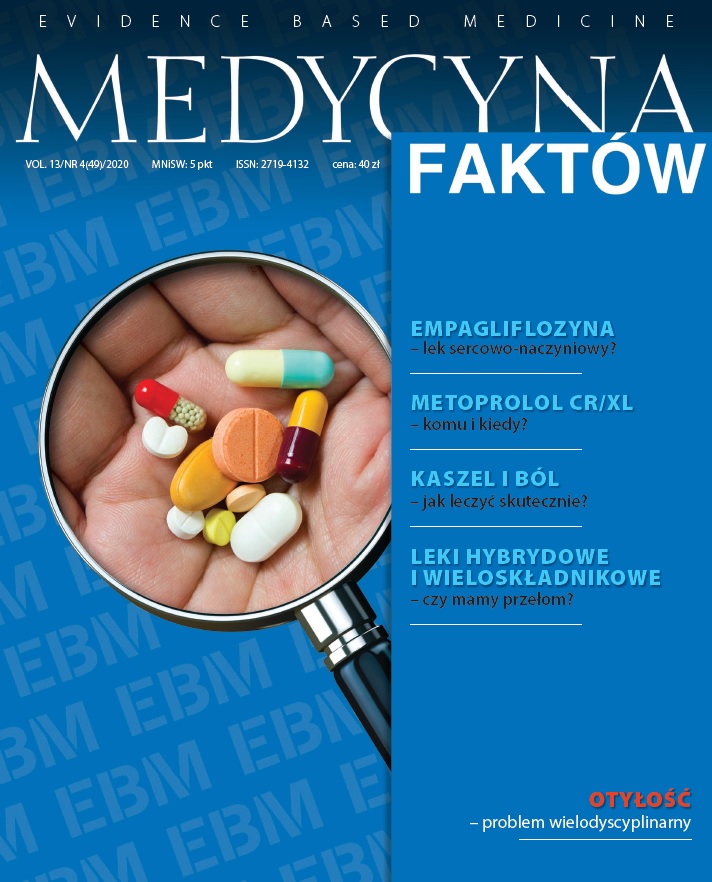Tourist routes of 2020 – time for Orla Perć! How to make difficult clinical decisions Meeting Proceedings
Main Article Content
Abstract
In modern medicine, there is less and less room for worn-out schemes. Even though patients are initially diagnosed with the same illness, it often turns out in an in-depth medical interview how much they differ from each other. Not only the subtype of the disease itself is important, but also the lifestyle, the type of work performed, tolerance of adverse effects of the implemented therapy, or, as in the case of young women, maternal plans. Ignoring the reported plans, symptoms, and inadequacy of treatment for a given patient may result in a patient’s withdrawal of pharmacotherapy. Cardiological pharmacotherapy is an excellent example of this. The choice of a drug based on the subtype of hypertension, heart failure, or arrhythmia, a dosage regimen that takes into account daily habits and the absence of side effects, allows to achieve the best compliance. Therefore, it is necessary to take into account the differences in the properties of particular substances within one group – β-adrenolytics, angiotensin-converting-enzyme inhibitors, or calcium channel blockers. β-adrenolytics with vasodilatation effect bring different clinical benefits than those strongly cardioselective, new calcium antagonists cause fewer side effects with the same efficacy, and the use of well-studied drug combinations allows to reduce the number of tablets taken, reducing the risk of missing a dose.
Article Details
Copyright © by Medical Education. All rights reserved.
References
2. Tykarski A, Filipiak KJ, Januszewicz A et al. Zasady postępowania w nadciśnieniu tętniczym – 2019 rok. Nadciśnienie Tętnicze w Praktyce. 2019; 5(1): 1-86.
3. Julius S, Palatini P, Kjeldsen SE et al. Usefulness of heart rate to predict cardiac events in treated patients with high-risk systemic hypertension. Am J Cardiol. 2012; 109(5): 685-92.
4. Prejbisz A, Dobrowolski P, Kosiński P et al. Postępowanie w nadciśnieniu tętniczym u kobiet w ciąży. Zapobieganie, diagnostyka, leczenie i odległe rokowanie. Stanowisko Polskiego Towarzystwa Nadciśnienia Tętniczego, Polskiego Towarzystwa Kardiologicznego oraz Polskiego Towarzystwa Ginekologów i Położników. Ginekologia i Perinatologia Praktyczna. 2019; 4(2): 43-111.
5. Duan L, Angie Ng, Wansu Chen et al. Beta-blocker subtypes and risk of low birth weight in newborns. J Clin Hypertens (Greenwich). 2018; 20(11): 1603-9.
6. ESC Guidelines for the diagnosis and management of atrial fibrillation developed in collaboration with the European Association for Cardio-Thoracic Surgery (EACTS). Eur Heart J. 2020; ehaa612.
7. Kühlkamp V, Schirdewan A, Stagl K et al. Use of metoprolol CR/XL to maintain sinus rhythm after conversion from persistent atrial fibrillation: a randomized, double-blind, placebo-controlled study. J Am Coll Cardiol. 2000; 36(1): 139-46.
8. Głuszek J, Pawlaczyk K. Działania niepożądane antagonistów wapnia. Choroby Serca i Naczyń. 2006; 3(1): 18-31.
9. Mancia G, Coca A, Chazova I et al. Effects on office and home blood pressure of the lercanidipine-enalapril combination in patients with Stage 2 hypertension: a European randomized, controlled clinical trial. J Hypertens. 2014; 32(8): 1700-7.
10. Ghiadoni L, Bruno RM, Cartoni G et al. Combination therapy with lercanidipine and enalapril reduced central blood pressure augmentation in hypertensive patients with metabolic syndrome. Vascul Pharmacol. 2017; 92: 16-21.
11. Rump ChL. Efficacy and tolerability of the fixed lercanidipine-enalapril combination in the treatment of patients with essential hypertension. Arzneimittelforschung. 2010; 60(3): 124-30.
12. Puig JG, Calvo C, Luurila O et al. Lercanidipine, enalapril and their combination in the treatment of elderly hypertensive patients: placebo-controlled, randomized, crossover study with four ABPM. J Hum Hypertens. 2007; 21: 917-24.
13. Robles NR, Sobrino J, Calvo C et al. Lercanidipine valuable effect on urine protein losses: the RED LEVEL study. Curr Med Res Opin. 2016; 32(suppl 2): 29-34.

